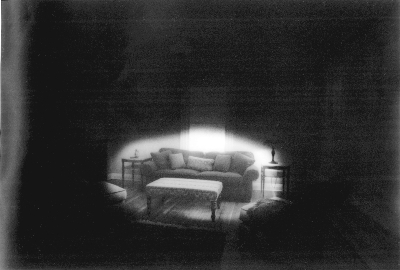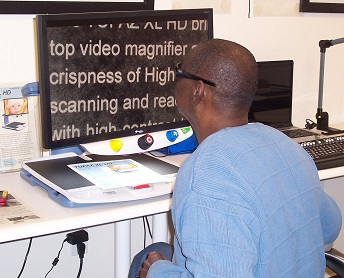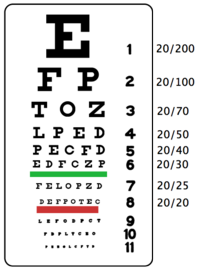Facts about Low Vision
Most surveys and studies indicate that the majority of people in the United States with vision loss are adults who are not totally blind; instead, they have what is referred to as low vision. You may have heard the terms “partial sight” or “partial blindness” or even “poor vision” also used to describe low vision. Those descriptions are no longer in general use, however.
Here is one definition of low vision, related to visual acuity:
- Low vision is a condition caused by eye disease, in which visual acuity is 20/70 or poorer in the better-seeing eye and cannot be corrected or improved with regular eyeglasses. (Scheiman, Scheiman, and Whittaker)
Visual Acuity and Low Vision
Visual acuity is a number that indicates the sharpness or clarity of vision. A visual acuity measurement of 20/70 means that a person with 20/70 vision who is 20 feet from an eye chart sees what a person with unimpaired (or 20/20) vision can see from 70 feet away.
20/70 can best be understood by examining a standard eye testing chart that you may have used in your own doctor’s office during an eye examination.
In the United States, the Snellen Eye Chart (pictured at left) is a test that ophthalmologists and optometrists use to measure a person’s distance visual acuity. It contains rows of letters, numbers, or symbols printed in standardized graded sizes.
Your eye doctor will ask you to read or identify each line or row at a fixed distance (usually 20 feet), although a 10-foot testing distance is also used.
If you can read line 8 (D E F P O T E C) from 20 feet away while wearing your regular glasses or contact lenses, the doctor records your vision (or visual acuity) as 20/20 with best correction.
If the smallest print you can read is line 3 (T O Z) from 20 feet away while wearing your regular glasses or contact lenses, the doctor records your vision (or visual acuity) as 20/70 with best correction.
Please note: An actual Snellen Eye Chart is much larger than the one depicted here; therefore, it’s not recommended that you use this chart to test your own (or a friend’s or family member’s) visual acuity.
A Functional Definition of Low Vision
Not all eye care professionals agree with an exclusively numerical (or visual acuity) description of low vision. Here’s another — more functional — definition of low vision:
- Low vision is uncorrectable vision loss that interferes with daily activities. It is better defined in terms of function, rather than [numerical] test results. (Massof and Lidoff)
- In other words, low vision is “not enough vision to do whatever it is you need to do,” which can vary from person to person.
- Most eye care professionals prefer to use the term “low vision” to describe permanently reduced vision that cannot be corrected with regular glasses, contact lenses, medicine, or surgery.
- If you have low vision, it is necessary to have a different kind of eye examination that uses different and more detailed tests to determine what you can and cannot see. You can learn more about these specialized eye charts and testing procedures at What is a Low Vision Examination?
Low Vision vs. Legal Blindness
“Legal blindness” is a definition used by the United States government to determine eligibility for vocational training, rehabilitation, schooling, disability benefits, low vision devices, and tax exemption programs. It’s not a functional low vision definition and doesn’t tell us very much at all about what a person can and cannot see.
Part 1 of the U.S. definition of legal blindness states this about visual acuity:
- A visual acuity of 20/200 or less in the better-seeing eye with best conventional correction (meaning with regular glasses or contact lenses).
This is a 20/200 visual acuity measurement, correlated with the Snellen Eye Chart (pictured above):
- If you can only read line 1 (the big “E”) from 20 feet away while wearing your regular glasses or contact lenses, the doctor records your vision (or visual acuity) as 20/200 with best correction.
- Update: In 2007, the Social Security Administration updated the criteria for measuring legal blindness when using newer low vision test charts with lines that can measure visual acuity between 20/100 and 20/200. Under the new criteria, if a person’s visual acuity is measured with one of the newer charts, and they cannot read any of the letters on the 20/100 line, they will qualify as legally blind, based on a visual acuity of 20/200 or less.
Part 2 of the U.S. definition of legal blindness states this about visual field:
- OR a visual field (the total area an individual can see without moving the eyes from side to side) of 20 degrees or less (also called tunnel vision) in the better-seeing eye.
This is a representation of a constricted visual field:

Source: Making Life More Livable. Used with permission.
For more information on the definitions of legal blindness, you can read Disability Evaluation Under Social Security, a publication from the Social Security Administration.
Using Low Vision Optical and Non-Optical Devices
Low vision optical, non-optical, and electronic magnifying devices can make it possible for you to do a variety of everyday tasks, including
To learn more about the many different types of reading options that are available, see Reading, Writing, and Vision Loss on the VisionAware website.
Next Steps: What Can I Still Do If I Am Legally Blind?

You can still read. – You can still cook. – You can still work. – In other words, you can still enjoy life! – Check out our Getting Started Kit for more ideas to help you live well with low vision. – Read about Ben Karpilow, a visually impaired attorney who practices disability law in California.
Visual Impairment
Much like low vision, there are many different definitions of visual impairment. “Visual impairment” is a general term that describes a wide range of visual function, from low vision through total blindness.
Here is an example of the variations in the term “visual impairment” or “visually impaired” from the World Health Organization Levels of Visual Impairment:
Moderate Visual Impairment:
- Snellen visual acuity = 20/70 to 20/160
Severe Visual Impairment:
- Snellen visual acuity = 20/200 to 20/400
- OR visual field of 20 degrees or less
Profound Visual Impairment:
- Snellen visual acuity = 20/500 to 20/1000
- OR visual field of 10 degrees or less
Like the term “legal blindness,” “visual impairment” is not a functional definition that tells us very much about what a person can and cannot see. It is a classification system, rather than a definition.
Light Perception and Light Projection
These terms describe the ability to perceive the difference between light and dark, or daylight and nighttime. A person can have severely reduced vision and still be able to determine the difference between light and dark, or the general source and direction of a light.
- The stereotypical assumption – that people who are blind or have low vision live in a type of “blackness” that sighted people see when they close their eyes – is generally not accurate.
- Although every person sees differently, including persons with low vision, an individual who has light perception/projection can perceive the presence or absence of light. Some people describe light perception as knowing when a room light is on or off, or being able to walk toward a lighted lamp on a table in an otherwise darkened room.
Total Blindness
Total blindness is the complete lack of light perception and form perception, and is recorded as “NLP,” an abbreviation for “no light perception.”
Few people today are totally without sight. In fact, 85% of all individuals with eye disorders have some remaining sight; approximately 15% are totally blind.
Living room image source: From Maureen A. Duffy, Making Life More Livable: Simple Adaptations for Living at Home After Vision Loss (New York, NY: AFB Press, American Foundation for the Blind, 2015), p. 11. © 2015 by American Foundation for the Blind. All Rights Reserved.

